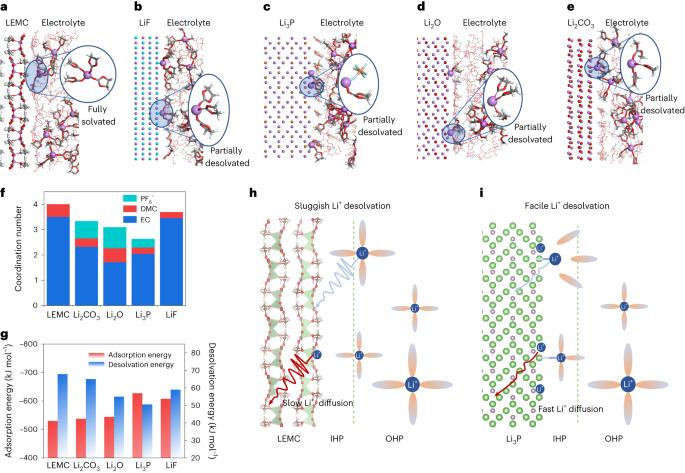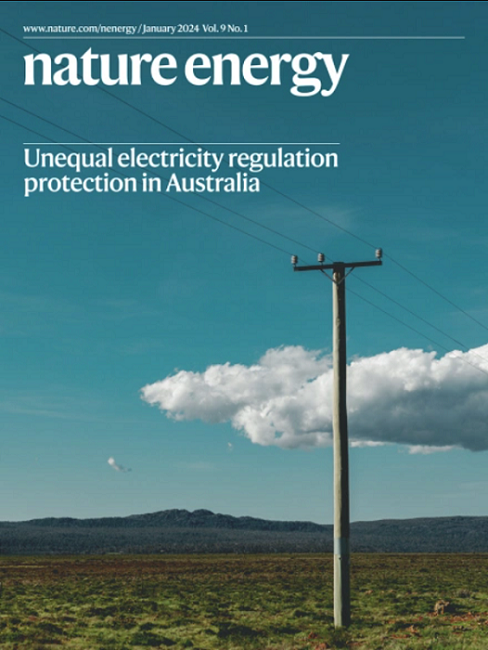基于 Li3P 的晶体固态电解质相间体实现石墨基锂离子电池的快速充电能力
IF 49.7
1区 材料科学
Q1 ENERGY & FUELS
引用次数: 4
摘要
电解质中的 Li+ 脱溶和固体-电解质相间层(SEI)的扩散是限制石墨基锂离子电池快速充电的两个决定性步骤。在这里,我们展示了可在无机物的内赫尔姆霍兹平面附近诱导出低溶剂配位的 Li+ 溶解结构。具体来说,与常规 SEI 成分相比,Li3P 可使 Li+ 的解溶障碍更低,Li+ 通过 SEI 的扩散能力更快。我们在石墨表面构建了一个超薄的 S 桥磷层,并将其原位转化为具有高离子电导率的结晶 Li3P SEI。采用这种石墨阳极的袋式电池在 10 分钟和 6 分钟(6C 和 10C)充电后,容量分别达到 91.2% 和 80%,在 6C 充电速率下超过 2,000 个循环的容量保持率为 82.9%。我们的工作揭示了 SEI 成分和结构调节对快速充电 LIB 的重要性。最先进的石墨阳极无法满足需求不断增长的市场对极速充电的要求。在此,研究人员开发了一种基于 Li3P 的固态电解质中间相,实现了石墨锂离子电池的快速充电(最短 6 分钟)。本文章由计算机程序翻译,如有差异,请以英文原文为准。

Fast-charging capability of graphite-based lithium-ion batteries enabled by Li3P-based crystalline solid–electrolyte interphase
Li+ desolvation in electrolytes and diffusion at the solid–electrolyte interphase (SEI) are two determining steps that restrict the fast charging of graphite-based lithium-ion batteries. Here we show that the low-solvent-coordination Li+ solvation structure could be induced near the inner Helmholtz plane on inorganic species. Specifically, Li3P could enable a lower Li+ desolvation barrier and faster Li+ diffusion capability through the SEI in comparison to the regular SEI components. We construct an ultrathin S-bridged phosphorus layer on a graphite surface, which in situ converts to crystalline Li3P-based SEI with high ionic conductivity. Our pouch cells with such a graphite anode show 10 min and 6 min (6C and 10C) charging for 91.2% and 80% of the capacity, respectively, as well as 82.9% capacity retention for over 2,000 cycles at a 6C charging rate. Our work reveals the importance of the SEI component and structure regulation for fast-charging LIBs. State-of-the-art graphite anodes cannot meet the extremely fast charging requirements of ever-demanding markets. Here the researchers develop a Li3P-based solid–electrolyte interphase, enabling fast (down to 6 min) charging of graphite-based Li-ion batteries.
求助全文
通过发布文献求助,成功后即可免费获取论文全文。
去求助
来源期刊

Nature Energy
Energy-Energy Engineering and Power Technology
CiteScore
75.10
自引率
1.10%
发文量
193
期刊介绍:
Nature Energy is a monthly, online-only journal committed to showcasing the most impactful research on energy, covering everything from its generation and distribution to the societal implications of energy technologies and policies.
With a focus on exploring all facets of the ongoing energy discourse, Nature Energy delves into topics such as energy generation, storage, distribution, management, and the societal impacts of energy technologies and policies. Emphasizing studies that push the boundaries of knowledge and contribute to the development of next-generation solutions, the journal serves as a platform for the exchange of ideas among stakeholders at the forefront of the energy sector.
Maintaining the hallmark standards of the Nature brand, Nature Energy boasts a dedicated team of professional editors, a rigorous peer-review process, meticulous copy-editing and production, rapid publication times, and editorial independence.
In addition to original research articles, Nature Energy also publishes a range of content types, including Comments, Perspectives, Reviews, News & Views, Features, and Correspondence, covering a diverse array of disciplines relevant to the field of energy.
 求助内容:
求助内容: 应助结果提醒方式:
应助结果提醒方式:


